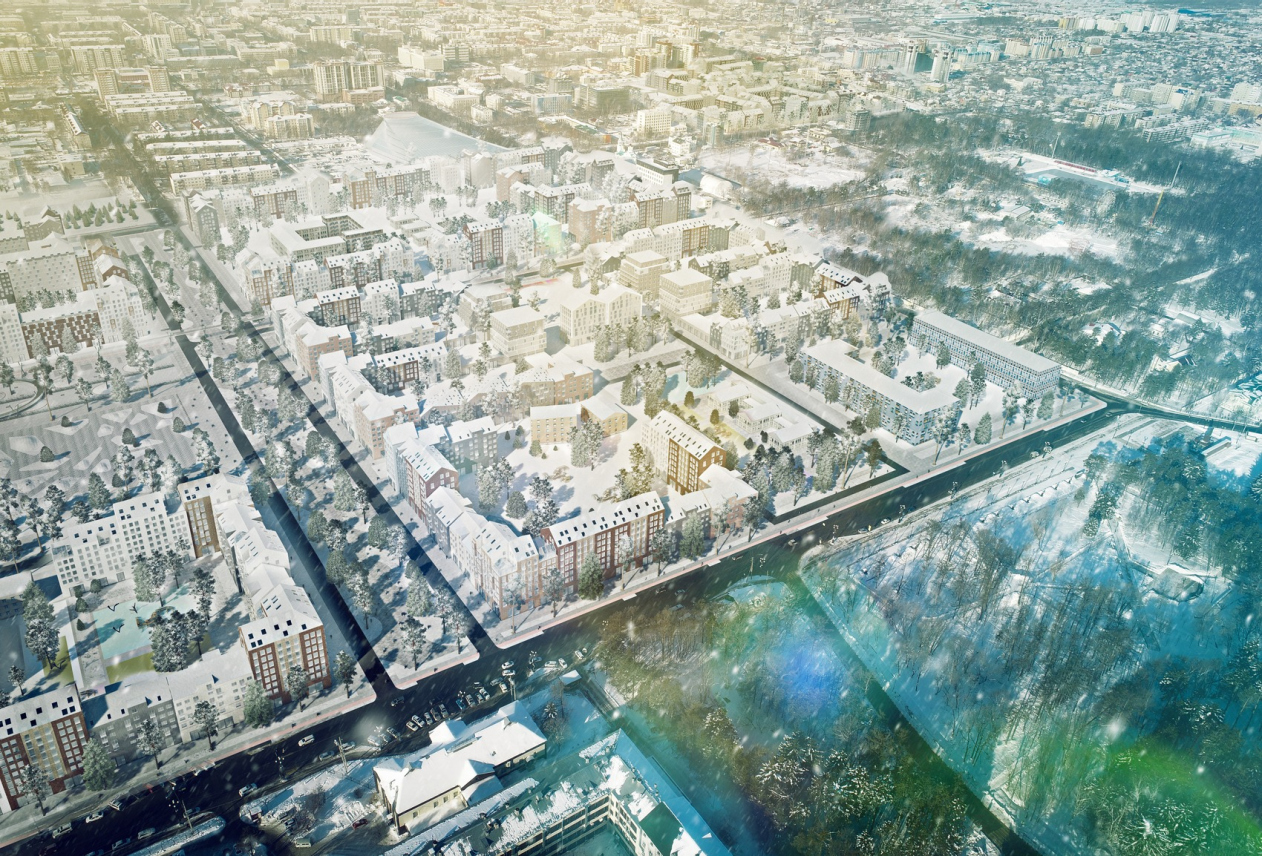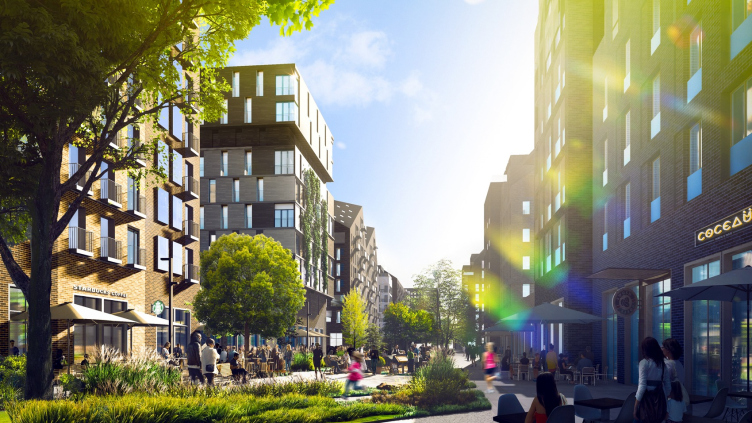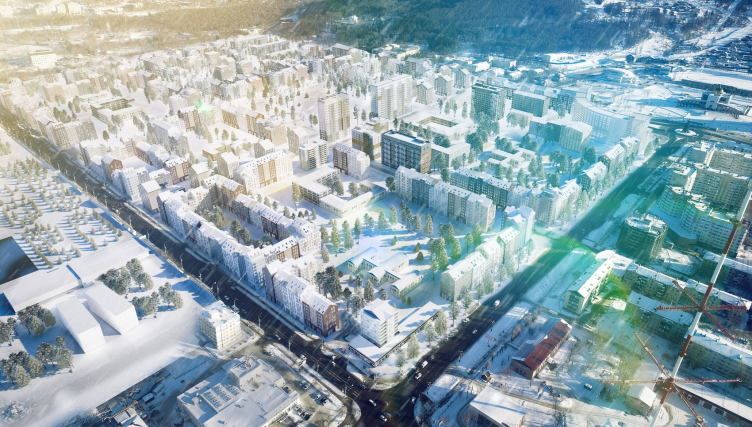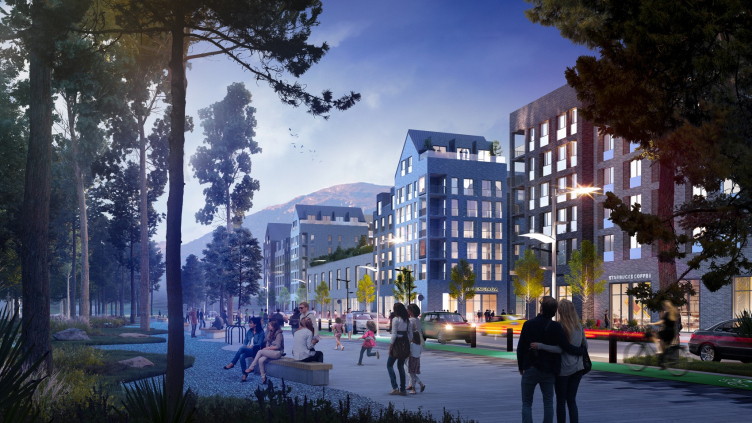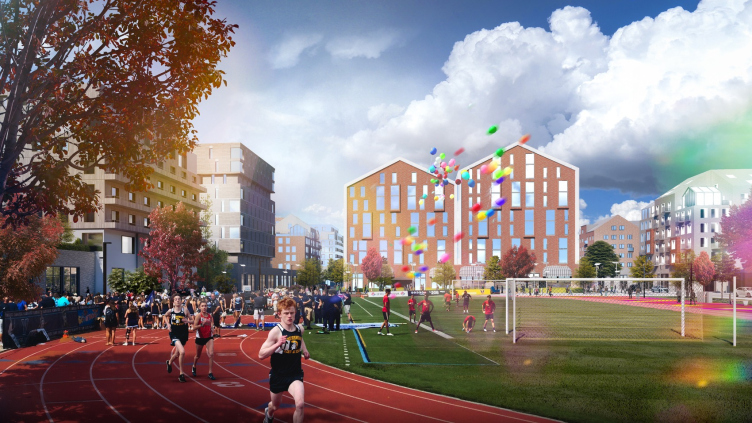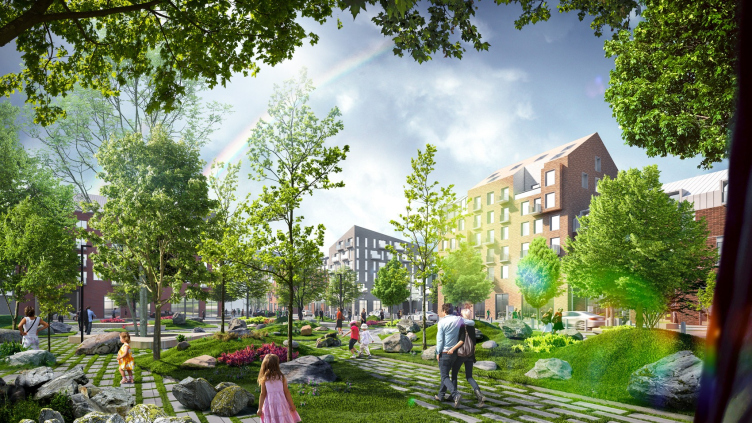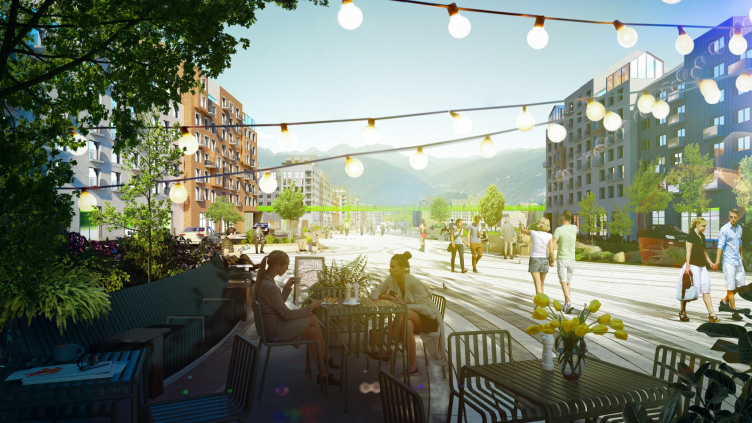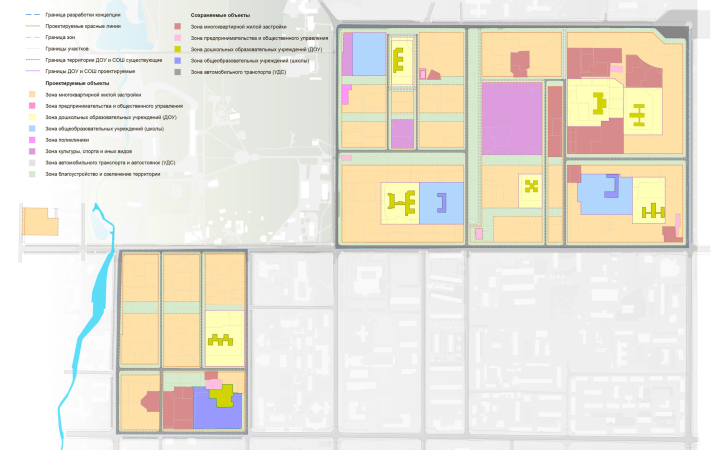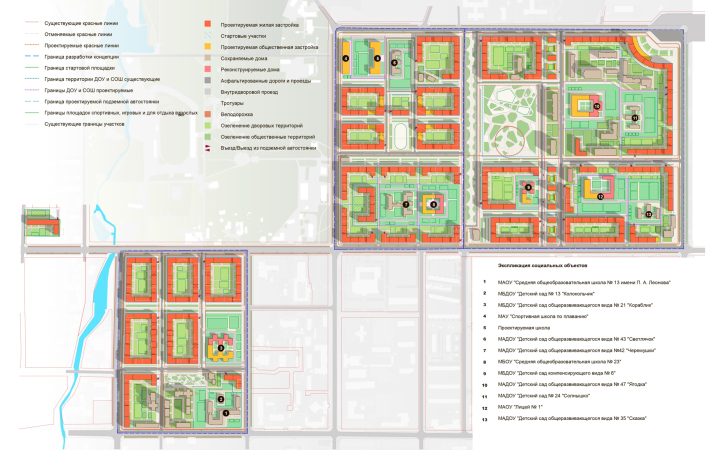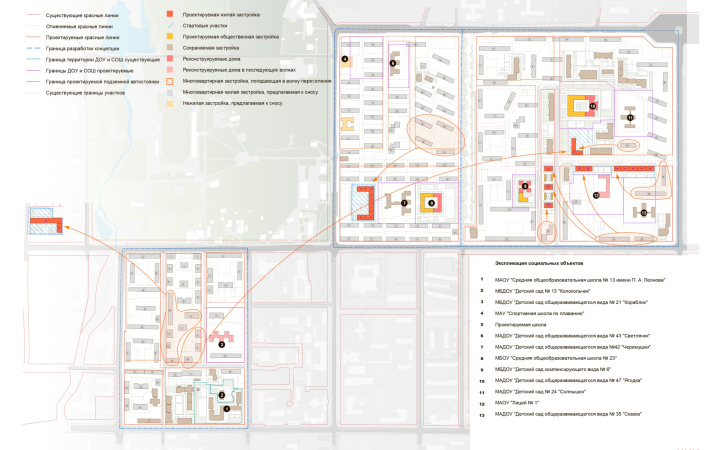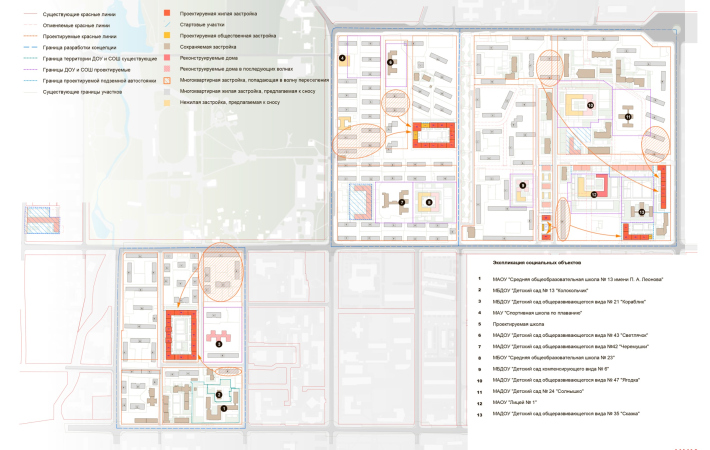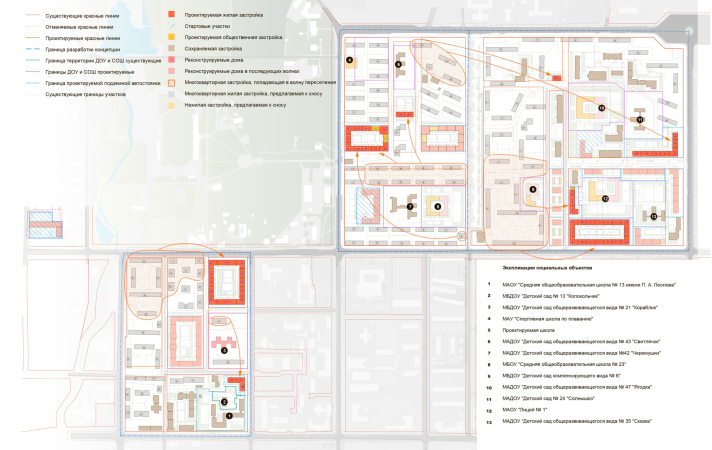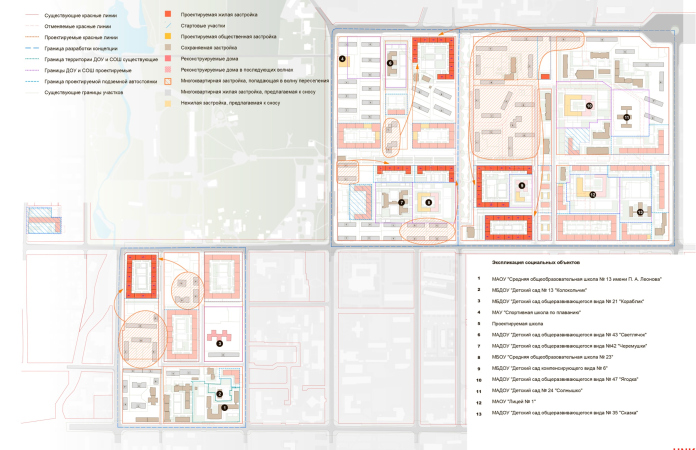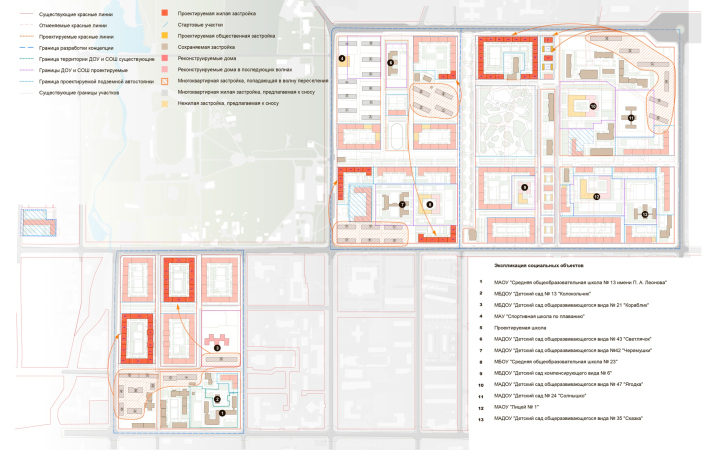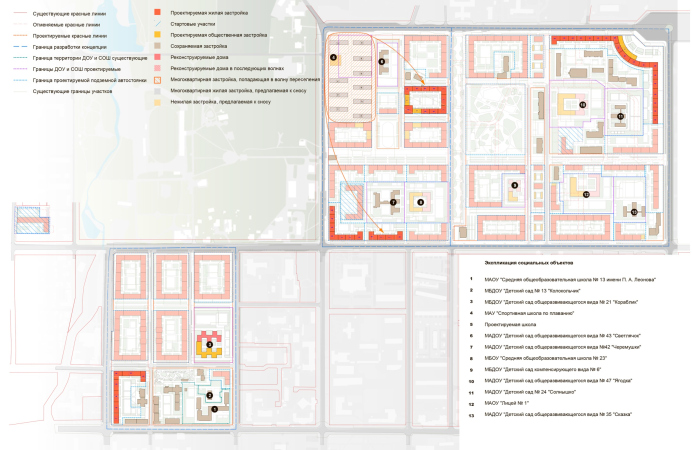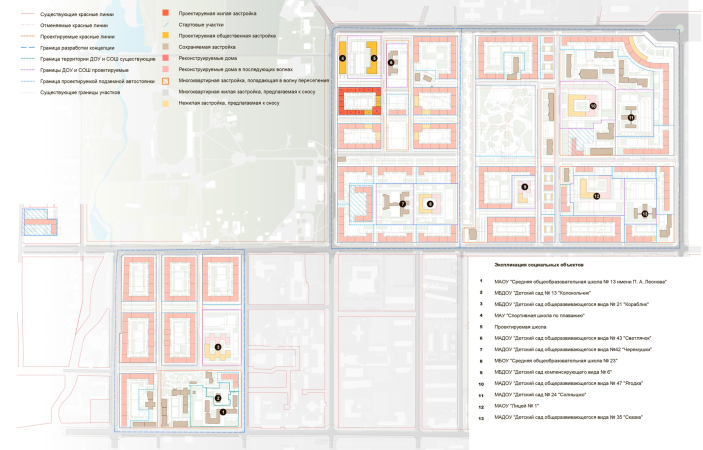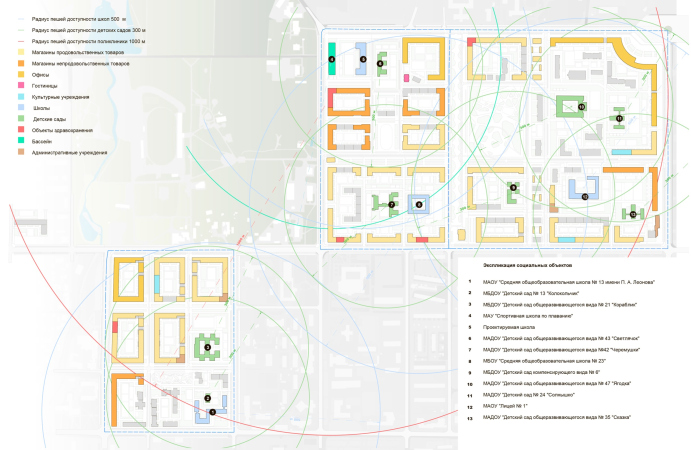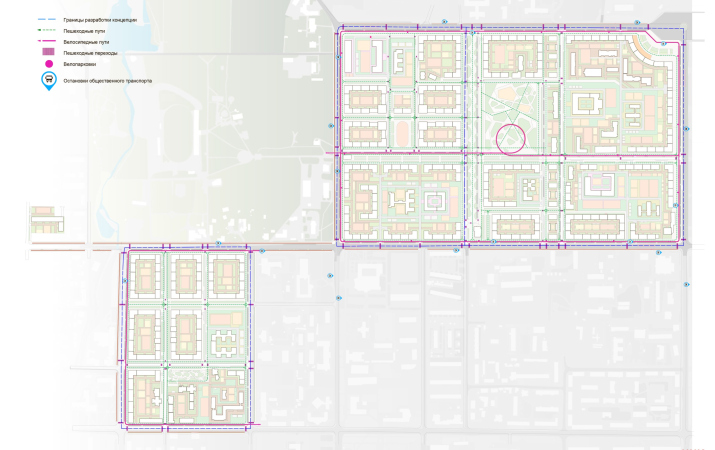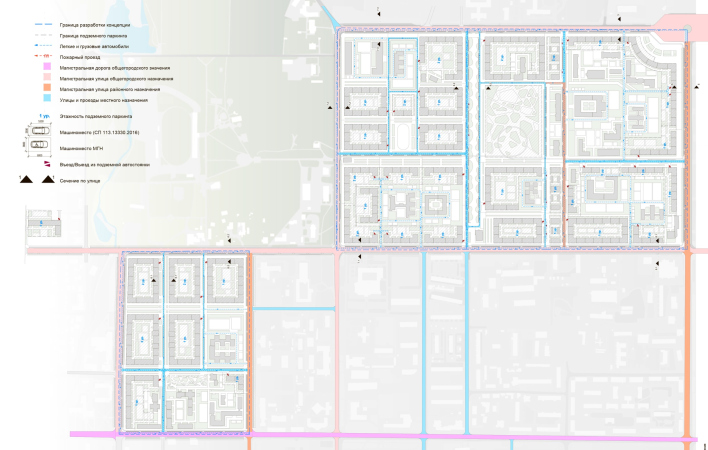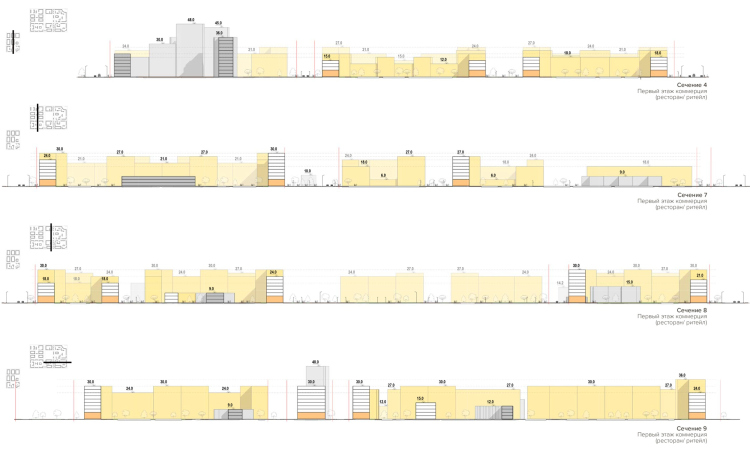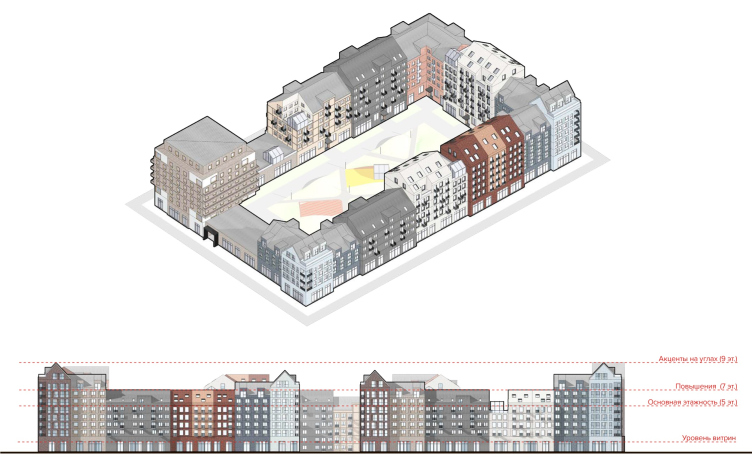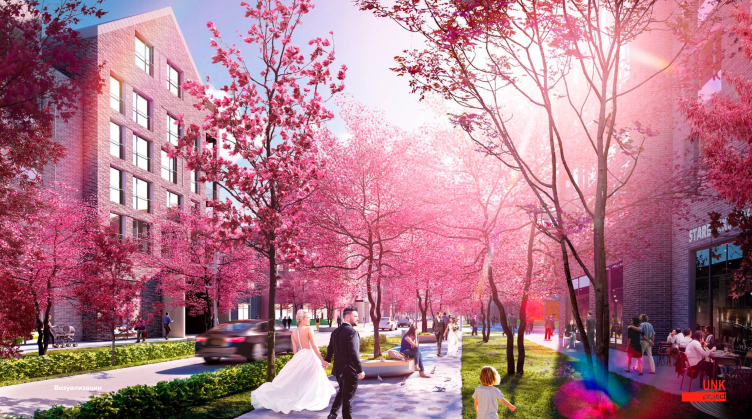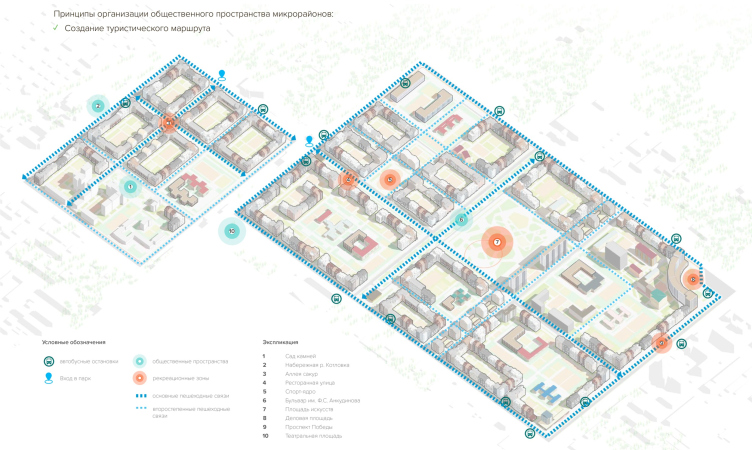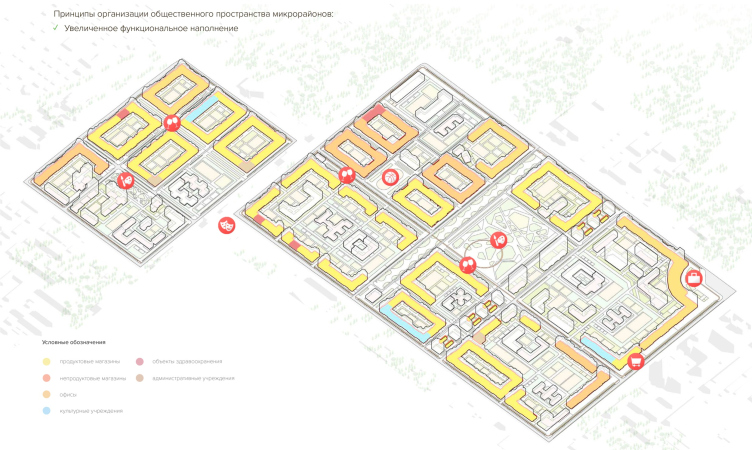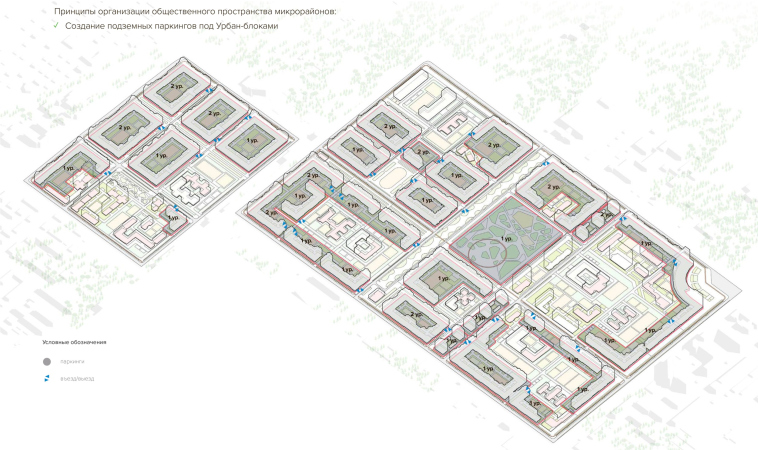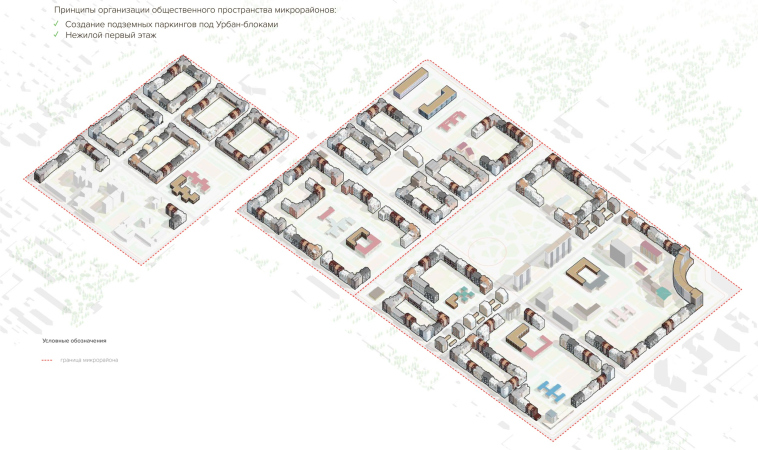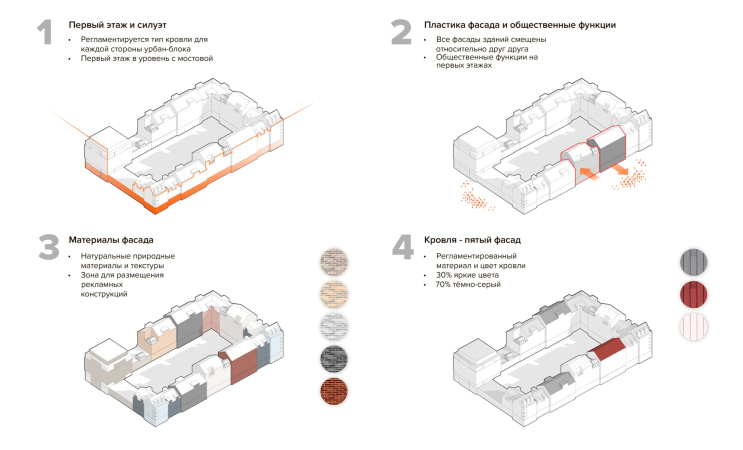The in-block Restorannaya Street in District 7. The development of architectural and town planning concept of developing the Yuzhno-Sakhalinsk area.
Copyright: © UNK project
View from the window into the yard. The development of architectural and town planning concept of developing the Yuzhno-Sakhalinsk area.
Copyright: © UNK project
Over the last few years, the city government of Yuzhno-Sakhalinsk has initiated a whole series of competitions, one of them being the competition for the concept of spatial development of the city, which was won by Ostozhenka, and a competition for the concept of an educational cluster, which was won by UNK project. This means at least three important things: first, there are unsolved town planning problems that Yuzhno-Sakhalinsk is currently facing, second, the moral and physical wear of the existing construction, and, third, the fact that the city government is prepared to be involved in an extensive dialogue on the subject.
Birds-eye view of District 8. The development of architectural and town planning concept of developing the Yuzhno-Sakhalinsk area.
Copyright: © UNK project
Birds-eye view of District 7. The development of architectural and town planning concept of developing the Yuzhno-Sakhalinsk area.
Copyright: © UNK project
Using the term “renovation” in the context of Yuzhno-Sakhalinsk, one must take into account one crucial detail: when Moscow is improving the city space and people’s living conditions, we are indeed speaking of “improvement”, i.e. making the city environment comply with some certain modern standards – meaning, you could leave everything as it was, at least, it is known that some of the old five-story housing projects opted out of getting on the renovation program by popular vote. When Yuzhno-Sakhalinsk committed itself to renovation – which started in the already mentioned District 8, where two municipal houses were built – it was all about total replacement of the housing stock, which was not just outdated but totally unfit for living, and dangerous for its residents due to the hazardous state it is in, as well as non-compliance with modern construction requirements in seismically active zones.
The entrance to the city block. The Raionnaya Street. The Komsomolsky Avenue. The development of architectural and town planning concept of developing the Yuzhno-Sakhalinsk area.
Copyright: © UNK project
View of the inner yard. The development of architectural and town planning concept of developing the Yuzhno-Sakhalinsk area.
Copyright: © UNK project
This is why the renovation program in Yuzhno-Sakhalinsk is not as commercially charged, and does not require any “Moscow coefficient” of increasing the construction density. In Yuzhno-Sakhalinsk, according to the competition brief, with the current population density of 20,852 people per square kilometer, the increase in housing density will only be 9%, i.e. 22,288 people per square kilometer. Expressed in architectural and town-planning terms, this, first of all, means an opportunity to keep the construction at a low-rise level – in the concept developed by UNK project, it does not exceed 4-9 floors, combined with an increase in the square footage of the apartments by 20% – as well as an opportunity for designing large yard and public areas.
The geographical context
The renovated Districts 7 and 8 – and here the UNK project initiative was supported by the local government – are to become the exemplary starting point, which will show the “future face” of the entire city. The housing construction here is based on implementing the typology of urban blocks – small-size perimeter blocks of houses with a clear division into the city and yard territories and a restricted car access. The idea of urban blocks has been in trend for a few years now at various urban planning forums. However, in spite of the fact that it was born concurrently to the Moscow renovation project, the nation’s capital still lacks urban blocks built at the city’s commission. As for renovation practice, so far it boils down to pinpoint construction, represented by separately standing high-rises.
The sports nucleus of District 7. The development of architectural and town planning concept of developing the Yuzhno-Sakhalinsk area.
Copyright: © UNK project
The “Zen Garden” park. The development of architectural and town planning concept of developing the Yuzhno-Sakhalinsk area.
Copyright: © UNK project
This fact, of course, has a rational explanation: there is a vast difference between the overpriced Moscow land and that of Yuzhno-Sakhalinsk. However, the Far East region presents difficulties of its own, having to do, first of all with the geographic specifics. First of all, the increased danger of earthquakes. If the architects tried to observe the Soviet construction standards, building urban blocks would be out of the question because those rules clearly stated that houses were to be built at a considerable distance from one another in case of an earthquake: if one house collapses it will not hit the one standing next to it. With the development of modern technologies for designing and calculating buildings, crash-tested in the neighboring Japan, the necessity for spacing the houses as far apart as possible became no longer relevant, and earthquake-proof buildings are now constructed by less archaic methods. All new homes ultimately provide structural strength that can withstand earthquakes up to 9 points.
The central boulevard. The development of architectural and town planning concept of developing the Yuzhno-Sakhalinsk area.
Copyright: © UNK project
Second, a big problem on Sakhalin, is the monsoon climate – there are recurrent cyclones with colossal amounts of snow. The head of UNK project Yuliy Borisov notes that this is not their first project in the region, the architects are already at home with these specifics, and, therefore, immediately implement the required solutions in their projects. For example, the width of the traffic way must be calculated with regard to snow disposal, while the contour of the roofs must also provide for accumulation of large masses of snow.
In addition, snowfalls are a particular pain in the head for motorists – and this is why the concept includes underground parking garages instead of open air parking lots, because this will spare the car owners the necessity to dig their cars from snow every morning. Virtually every urban block has an underground parking garage in front of it. The surplus budget of Yuzhno-Sakhalinsk can afford such a solution.
The construction principles
During the construction of urban blocks, the large cells of the Soviet town planning grid get fractured into a finer structure, where the size of the “module” do not exceed 2.5 hectares, its maximum length being 200 meters. The benefits provided by such structure have been repeatedly described. We will only remind you here that the concept of urban blocks became the key idea of the new regional town planning standards, which were a few years ago presented by the Committee for Architecture and Urban Planning of Moscow at the ArchModscow convention. The project was developed by RTDA, the operator of the current competition, and the same ideas can be traced here.
The key feature of the urban block system is accessibility – the architects create a chain of housing projects with walking access to social infrastructure projects, combined with a transparent and safe pedestrian environment. It is cut through by a so-called “green urban framework” – a chain of boulevards, city parks, and in-yard gardens that make it possible to integrate the new town planning formations into the natural mountainous landscape, and build a tourist route in the center of the city. For example, districts 7 and 8 are connected to the boulevard that connects the city park with the central square and with the business quarter.
The facade design code. An example of an urban block. The development of architectural and town planning concept of developing the Yuzhno-Sakhalinsk area.
Copyright: © UNK project
The sakura promenade. The development of architectural and town planning concept of developing the Yuzhno-Sakhalinsk area.
Copyright: © UNK project
The local residents – who took an active part in discussing the competition – paid special attention to this specific part of the project, literally examining which windows will command better mountain views.
Yuliy Borisov: “Our goal was to show town planning and architectural approaches to realizing renovation projects, but, most importantly, we had to get feedback from the local residents. We believe that the people of Yuzhno-Sakhalinsk were our coauthors because they indeed gave us a lot of valuable advice. The discussion coincided with the pandemic lockdown period, but we made a tent in the center of the city – some people would come there in person, and some discussed the project with us by video conferencing.”
The concept also provides for such an important feature of renovated environment as being multifunctional and diverse in terms of scenarios for using its territories: although the residential function does prevail, the project also provides for non-residential bottom floors, special designated areas for vegetable gardens and greenhouses, and creating new “centers of attraction”. The concept named the Teatralnaya Square, the Restorannaya Street, the Sports Field, “Business Center”, and “Sakura Boulevard”. Of course, while still in the concept stage, all of these are mere proposals that outline the main ideas for further town planning development.
The Central Square of District 8. The development of architectural and town planning concept of developing the Yuzhno-Sakhalinsk area.
Copyright: © UNK project
The very architecture of the urban block is designed upon the principle of diversity of the volumes, and variety of facade solutions, sort of united into a single city block. UNK project proposes to introduce into the concept a certain protocol – the so-called design code, which includes height, plastique, roof types, facade materials, and even placement of outdoor advertising structures. Applied to the new construction rules, such code could significantly improve the quality of the future design, resulting in better balanced and more convenient housing.
The Yuzhno-Sakhalinsk scenario
Yuliy Borisov believes that the renovation scenario, which was proposed to Yuzhno-Sakhalinsk, is quite appropriate for many other Russian cities of certain size, population density, and, most importantly, the price tag for the land. All this considering the fact that in the regions, where the land-to-construction cost ratio is far less dramatic than it in Moscow (where the main task during renovation is to squeeze as much square footage as possible), Russian cities nonetheless try to copy-paste the Moscow model, based on a fundamentally different economic situation. At the same time, the high-rise construction in the regions is very far from inexpensive, and, second, urban blocks only make sense when the number of floors stays under 9 – the architect emphasizes.
Those solutions that are contained in this renovation concept are, in my opinion, important and relevant not only for Yuzhno-Sakhalinsk. If the city succeeds in implementing these approaches on a systematic scale, this will be a great example for other Russian cities because Moscow is a separate agglomeration, with rules of its own, and now many cities are trying to copy the Moscow scenario, which, honestly, I do not think is the right thing to do. I would want to see a different approach to housing construction. There is a sensible solution – buildings of 8 or at most 9 stories high – these are backed by great economic figures, and it is convenient for the residents, so this is the scenario to be implemented.

